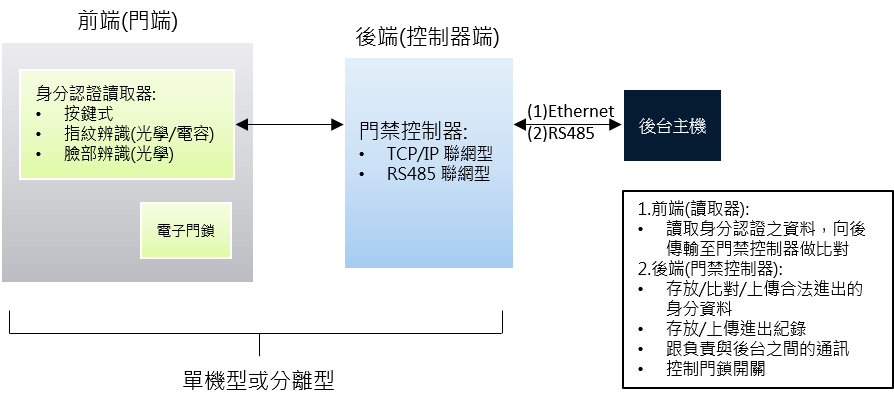This solution provides a hardware encryption and decryption engine to accelerate the encryption and decryption process to ensure sufficient security for the system. Ethernet also supports TCP/IP networking and up to 8 ADCs, which can detect backup battery power status and support other sensor requirements.
The architecture of the access control system includes
| 1. | Front-end reader (button type, RFID card reading type, fingerprint recognition type, face recognition type): |
|
|
| 2. | Back-end access controller (TCP/IP networking type, RS485 networking type): |
|
|
| 3. | The last backend host: |
 |
front-end reader
Front-end readers can be divided into: based on different identity authentication methods:
| 1. | Button type (using 8 bit, Cortex-M0 grade MCU) |
| 2. | RFID card reading type (using 8bit, Cortex-M0/M4 grade MCU) |
| 3. | Fingerprint recognition type (using ARM9, Cortex-M4 grade MCU) |
| 4. | Face recognition type (using ARM9 grade MCU) |
|
back-end access controller
The back-end access control controller can be divided into: according to the different communication interfaces connected to the backend:
| 1. | TCP/IP (Ethernet) networking type (using ARM9, Cortex-M4 grade MCU) |
| 2. | RS485 networking type (using Cortex-M4 grade MCU) |
Stand-alone or separate access control system
Traditional access control systems mostly use RS485 to communicate with the backend. In recent years, almost all newly developed access control systems use Ethernet to communicate with the backend. Generally speaking, the access management of the entire building (managing multiple doors) mostly adopts a separated architecture (the reader is separated from the access controller, and one access controller controls multiple readers). However, in small commercial offices or residential apartments, Most of them adopt a stand-alone architecture (the reader and access control controller are integrated into one complete machine).
Access Controller – Nuvoton’s corresponding MCU development platform and its product features
| 1. | Why NUC970 series (ARM9 core) is suitable for access control controllers |
|
|
| 2. | Why the M480 series (Cortex-M4 core) is suitable for access control controllers |
|

Blockdiagram
All reference designs on this site are sourced from major semiconductor manufacturers or collected online for learning and research. The copyright belongs to the semiconductor manufacturer or the original author. If you believe that the reference design of this site infringes upon your relevant rights and interests, please send us a rights notice. As a neutral platform service provider, we will take measures to delete the relevant content in accordance with relevant laws after receiving the relevant notice from the rights holder. Please send relevant notifications to email: bbs_service@eeworld.com.cn.
It is your responsibility to test the circuit yourself and determine its suitability for you. EEWorld will not be liable for direct, indirect, special, incidental, consequential or punitive damages arising from any cause or anything connected to any reference design used.
Supported by EEWorld Datasheet